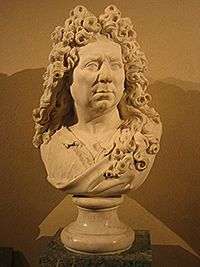Antoine Coysevox


Charles Antoine Coysevox (29 September 1640 – 10 October 1720), French sculptor, was born at Lyon, and belonged to a family which had emigrated from Franche-Comté, a Spanish possession at the time. The name should be pronounced quazevo.
Biography
Coysevox was only seventeen when he produced a statue of the Madonna of considerable merit; and having studied under Louis Lerambert and having further trained himself by taking copies in marble from Roman sculptures (among others from the Venus de Medici and the Castor and Pollux), he was engaged by the bishop of Strasbourg, Cardinal Fürstenberg, to adorn with statuary his château at Saverne (Zabern).
In 1666, he married Marguerite Quillerier, Lerambert's niece, who died a year after the marriage. In 1671, after four years spent working at Saverne, which was subsequently destroyed by fire in 1780, he returned to Paris. In 1676, his bust of the king's painter Charles Le Brun[1] obtained admission for him to the Académie Royale. A year later he married Claude Bourdict.
For niches on the façade of Jules Hardouin-Mansart's royal chapel at Les Invalides, he was commissioned to produce a Charlemagne (illustration) as a pendant to Nicolas Coustou's Louis XI. On the upper storey stand his Cardinal Virtues.
In consequence of the coordination of official arts that was exercised by Charles Le Brun between the years 1677 and 1685,[2] he was employed on behalf of Louis XIV in producing much of the decoration[3] and a large number of statues for Versailles; and he afterwards worked, between 1701 and 1709, with no less facility and success, for the Château de Marly, subsequently largely abandoned, then destroyed in the Revolution.


He executed Justice and Force and the River Garonne at Versailles. Among his works from Marly are the Mercury and the equestrian Fame (1702) and four groups commissioned for the "river" in the château's park; La Seine and its pendant at the head of the cascade, La Marne, Neptune and Amphitrite. Models in weather-resistant stucco were set up in 1699, replaced by marbles when they were finished in 1705. The groups were seized as biens nationaux in 1796 and dispersed: the Seine and Marne went to Saint-Cloud, and the Neptune and Amphitrite went to Brest in 1801.
In his portrait sculptures, the likenesses were said to have been remarkably successful; he produced portrait busts of most of the celebrated men of his age, including Louis XIV and Louis XV at Versailles, Colbert (the kneeling figure of his tomb at Saint-Eustache), Cardinal Mazarin (in the church of the Collège des Quatre-Nations), the Grand Condé (in the Louvre), Maria Theresa of Austria, Turenne, Vauban, Cardinal de Bouillon and de Polignac, the duc de Chaulnes (National Gallery of Art, Washington); Fénelon, Racine, André Le Nôtre (church of St-Roch); Bossuet (in the Louvre), the comte d'Harcourt, William Egon Cardinal Fürstenberg as well as Charles Le Brun (in the Louvre).
Coysevox died in Paris, 10 October 1720.
Besides the works given above, he carved about a dozen funeral monuments, including those to Colbert (at Saint-Eustache), to Cardinal Mazarin (in the Louvre), and to the painter Le Brun (in the church of Saint Nicolas-du-Chardonnet).
Between 1708 and 1710 Coysevox produced three further sculptures for Marly, a Pan (now in the Louvre), flanked by a Flora and a Dryad (in the Tuileries Gardens). A highly finished terracotta bozzetto or reduction of the Dryad, signed and dated 1709, is in the Ashmolean Museum, Oxford.[4]
Among the pupils of Coysevox were Nicolas and Guillaume Coustou and René Frémin.
Notes
- ↑ The terracotta is at the Wallace Collection, London (S60); the marble (1678) is at the Louvre Museum.
- ↑ Le Brun's design control over the sculptors carrying out assignments, even apart from the special case of Versailles was analysed in detail in Jennifer Montagu, "Charles Le Brun and His Sculptors: A Reconsideration in the Light of Some Newly Identified Drawings" The Burlington Magazine 118No. 875 (February 1976), pp. 88-95.
- ↑ The "War" Vase of 1684, an improvisation upon the Medici Vase was delivered by Coysevox; its companion, the "Peace" Vase was carved by Jean-Baptiste Tuby.
- ↑ J. Byam Shaw and Ian Robertson, "Sir Karl Parker and the Ashmolean" The Burlington Magazine 104 No. 715 (October 1962), p 429 (illus.), 432.
References
-
 This article incorporates text from a publication now in the public domain: Chisholm, Hugh, ed. (1911). "article name needed". Encyclopædia Britannica (11th ed.). Cambridge University Press.
This article incorporates text from a publication now in the public domain: Chisholm, Hugh, ed. (1911). "article name needed". Encyclopædia Britannica (11th ed.). Cambridge University Press. - L. Benoist, Coysevox (Paris: Séries Les Maîtres de l'art) 1930.
- François Souchal; Françoise de La Mourèyre; Henriette Dumuis, French Sculptors of the 17th and 18th Centuries, the Reign of Louis XIV, Catalogue A-F (Oxford: Bruno Cassirer) 1977. Contains the latest, revised biography and list of works.
External links
| Wikimedia Commons has media related to Antoine Coysevox. |
- Web Gallery of Art
- Art Renewal Center
- Louvre Database (French language)
- Insecula (French language)
- Catholic Encyclopedia article
- Antoine Coysevox in American public collections, on the French Sculpture Census website
